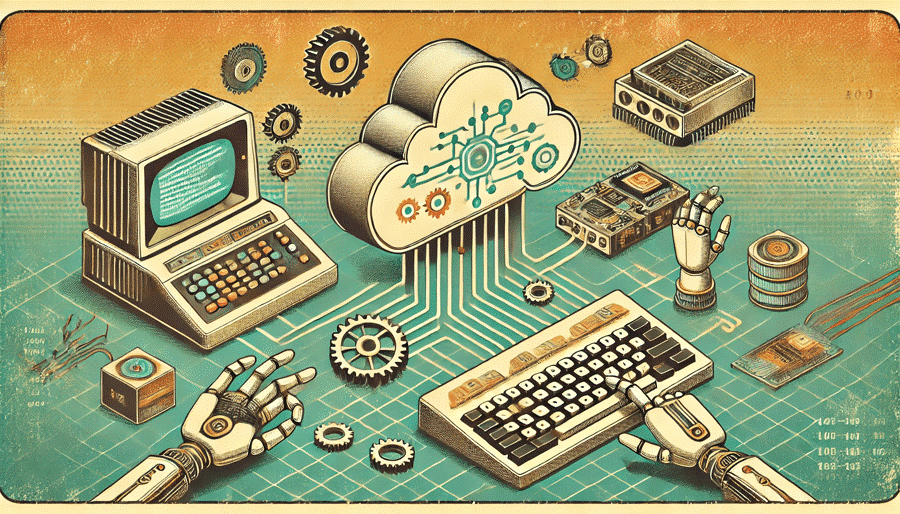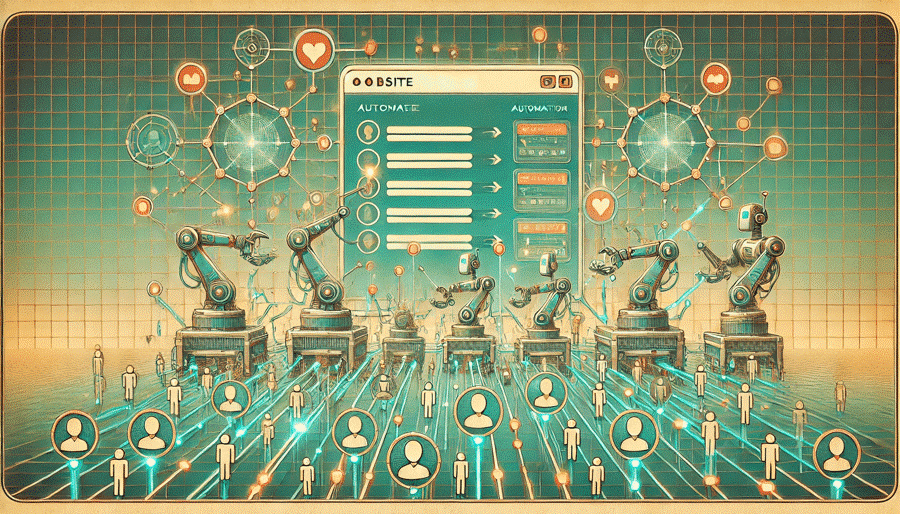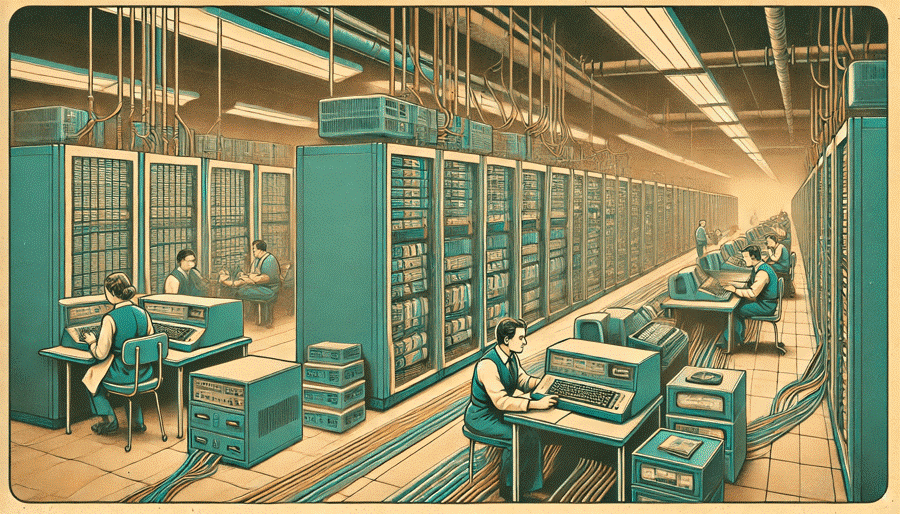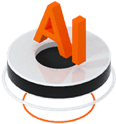
Businesses today face constant challenges—managing data, keeping operations running smoothly, and adapting to growth. These are no small tasks, but modern tools like cloud computing, Artificial Intelligence (AI), and automation can help.
By combining these technologies, businesses can automate repetitive tasks, use AI to understand patterns and trends in their data, and rely on the cloud to handle growing demands, allowing them to focus on planning and solving more important challenges.
Let's explore how these technologies work together to support smarter, more efficient business operations.
Artificial Intelligence (AI) is a type of technology that helps machines think and learn like humans. For example, AI can analyze sales data to predict which products will be popular next month, helping businesses prepare for demand. This ability to forecast trends makes AI a valuable tool for decision-making. According to Survey, nearly half of businesses now use AI in multiple parts of their operations.
Automation, on the other hand, focuses on handling repetitive tasks with minimal human involvement. For instance, automation can send out appointment reminders or schedule social media posts automatically. This reduces time spent on mundane activities and lowers the chance of errors. Surveys show that 89% of executives rank AI and automation as top priorities for improving efficiency and reducing costs (HBR Report).
Combining AI with web automation allow businesses to save time, cut costs, and make smarter decisions. For example, AI can identify areas that need improvement, while automation implements the necessary changes, creating a smoother workflow. This combination is becoming essential for businesses aiming to stay competitive in a fast-changing world.

Cloud computing is like renting a massive warehouse to store your tools and supplies. Instead of buying expensive servers and maintaining them yourself, you pay for access to a secure online system that handles data storage, processing, and software. Businesses can scale their usage based on needs, paying only for what they use.
Cloud platforms are essential for AI and automation because they provide the computing power needed to analyze large datasets and run complex algorithms. For example, a company can use the cloud to analyze customer purchase trends and predict which products will be in demand next month.
Think of it like a shared kitchen with state-of-the-art appliances—you don’t have to own everything yourself, but you still get the benefits of top-tier tools.
Think of AI, automation, and the cloud as the ultimate teamwork trio. Each plays a specific role—AI provides intelligence, automation executes tasks, and the cloud supplies the infrastructure to make everything happen at scale. Together, they enable businesses to save time, make better decisions, and grow without hitting technical or operational barriers.
Automation handles repetitive tasks such as sending invoices, updating inventory, or managing emails. This allows employees to focus on more strategic or creative tasks. For instance, a retail business could automate daily inventory checks, giving store managers more time to plan promotions or customer experiences.
AI can analyze large amounts of data quickly, uncovering patterns and trends that are often invisible to humans. For example, it might identify inefficiencies in a supply chain, such as delays or unnecessary costs, and suggest optimizations. Additionally, AI can process customer behavior data to recommend personalized offers, helping businesses improve customer satisfaction and drive sales. By providing actionable insights, AI enables businesses to make informed decisions, adapt to changes faster, and stay ahead of the competition.
One of the biggest advantages of using it is the cloud scalability. Businesses can increase or decrease resources based on demand without worrying about upgrading hardware. For instance, an e-commerce platform can scale its computing power to handle high traffic during a holiday sale and reduce it afterward to save costs. This flexibility ensures smooth operations regardless of workload.

AI, automation, and cloud computing are transforming industries by addressing real-world challenges and delivering innovative solutions. From retail to healthcare, these technologies are helping businesses become more efficient, customer-focused, and adaptive to change. Here are some examples of how they are making an impact:
Retailers often struggle to provide instant, accessible product details or promotions, especially during peak shopping times. For example, long lines at checkout or outdated promotional materials can frustrate customers.
AI-powered tools can help by generating dynamic QR code that link customers directly to product information, discounts, or contactless payment options. Automation ensures these QR codes are updated in real-time as promotions change, while cloud platforms store and manage the codes for easy access. This simple solution not only streamlines the shopping experience but also reduces operational bottlenecks.
Scheduling in healthcare is a complex challenge with frequent issues like no-shows or overbooked appointments disrupting operations. These inefficiencies waste resources and affect patient care.
AI can predict patient behavior, such as likely cancellations, by analyzing historical data. Automation follows up by sending reminders or rescheduling appointments as needed. The cloud ensures all scheduling data is accessible in real time across departments, reducing errors and improving coordination. This integration helps healthcare providers save time and focus on delivering quality care.
Logistics companies frequently face challenges like high operational costs, inefficient route planning, and unexpected delivery delays. These issues can lead to increased expenses, late shipments, and unsatisfied customers, all of which negatively impact business operations and reputation.
That’s where smart logistics solutions come into play. Powered by AI and automation, these systems analyze real-time traffic data and package destinations to determine the fastest delivery routes. Automation keeps drivers informed with real-time updates on traffic changes or new priorities. Cloud computing ensures seamless communication between logistics teams and enables comprehensive tracking of shipments, providing full visibility to the company and its customers.
When a website suddenly gets more visitors than expected—like during a big sale or product launch—it can slow down or even crash. This frustrates users and often leads to lost sales for the business.
To avoid these problems, AI tools can predict when traffic spikes might happen by analyzing past data. Automation simulates high website traffic to test how well the site can handle extra visitors. The cloud provides the flexible storage and computing power needed for these tests, making sure they run smoothly. By catching potential issues ahead of time, businesses can ensure their websites stay fast and reliable, even during busy times.

Before cloud computing, businesses relied heavily on on-premise servers and manual processes for tasks like data storage and analysis. This setup was expensive, required extensive maintenance, and lacked flexibility, limiting smaller businesses' ability to scale or adapt.
The transition to cloud-based systems changed everything. Companies could access scalable resources without the need for costly infrastructure. Automation further streamlined repetitive tasks, while AI provided the intelligence to make data-driven decisions. Together, these technologies have paved the way for a more agile and efficient approach to business operations.
Looking ahead, advancements like edge computing will bring data processing closer to its source, reducing latency and improving speed. As cloud providers adopt greener practices, these systems will become more sustainable and efficient, further solidifying their role in modern business.
While the benefits of these technologies are clear, businesses often face hurdles when adopting them. Addressing these challenges requires a balanced approach that acknowledges the obstacles and offers practical solutions.
● Integration Complexity: Implementing AI and automation into existing systems can be a complicated task, especially for businesses with legacy infrastructure. To overcome this, businesses can start with pilot projects or use pre-integrated solutions provided by cloud platforms to simplify adoption.
● Cost Concerns: The upfront costs of adopting new technologies can deter smaller businesses. Flexible subscription models offered by cloud providers help reduce financial barriers, and businesses can prioritize automation in high-impact areas to maximize ROI.
● Skill Gaps: Many organizations lack the internal expertise needed to deploy and manage AI and automation effectively. Training employees and hiring specialists can bridge this gap. Additionally, leveraging user-friendly tools with built-in automation capabilities can ease the learning curve.
● Trust and Transparency: The opacity of some AI systems can make businesses hesitant to rely on them for critical decisions. Ensuring the use of explainable AI models and providing transparency in processes can build confidence among stakeholders.
By tackling these challenges head-on with a mix of strategic planning and leveraging cloud-based solutions, businesses can pave the way for successful implementation of AI and automation in their operations.

The future of AI and cloud computing is dynamic and filled with exciting possibilities that promise to reshape the business landscape:
● Hybrid Cloud Strategies: Many businesses are moving towards hybrid cloud solutions, combining the benefits of private and public clouds. This approach provides flexibility, enhanced data security, and cost optimization, making it a preferred choice for businesses of all sizes.
● Sustainability Focus: With growing concerns about environmental impact, cloud providers are adopting greener practices, including renewable energy-powered data centers and efficient cooling technologies. These advancements make the cloud more sustainable for long-term use.
● Edge Computing: Processing data closer to its source, such as on devices or local servers, reduces latency and improves speed. This trend is crucial for industries like healthcare and logistics that require real-time data processing.
● AI-Enhanced Automation: Automation will become increasingly intelligent, enabling businesses to automate not only repetitive tasks but also complex decision-making processes. Seamless integration with existing tools will drive efficiency further.
Businesses that stay ahead of these trends will be well-positioned to thrive in an increasingly digital world.
The integration of AI, automation, and cloud computing is more than just a technological advancement — it's a chance to work smarter and solve real-world challenges. These tools can make businesses faster, more adaptable, and better prepared for the future.
But here’s the real question: Are you ready to take the first step? Start small — maybe automate a single task or move a process to the cloud. Learn, adjust, and grow from there. Technology isn’t about replacing people; it’s about empowering them to focus on what truly matters.
The future isn’t something to wait for—it’s something to build. With AI and the cloud at your side, the opportunities are endless. So, what’s your first move? Let’s make it count.
Disclaimer: The views expressed herein are for reference only and don't necessarily represent the official views of Alibaba Cloud.
How Web Automation in the Cloud Is Shaping the Future of SEO
PM - C2C_Yuan - March 17, 2025
Alibaba Cloud Community - August 27, 2025
plavookac - June 2, 2025
ray - May 2, 2024
Alibaba Cloud Native Community - December 11, 2025
Alibaba Cloud Community - December 4, 2025
 Robotic Process Automation (RPA)
Robotic Process Automation (RPA)
Robotic Process Automation (RPA) allows you to automate repetitive tasks and integrate business rules and decisions into processes.
Learn More AI Acceleration Solution
AI Acceleration Solution
Accelerate AI-driven business and AI model training and inference with Alibaba Cloud GPU technology
Learn More Function Compute
Function Compute
Alibaba Cloud Function Compute is a fully-managed event-driven compute service. It allows you to focus on writing and uploading code without the need to manage infrastructure such as servers.
Learn More Offline Visual Intelligence Software Packages
Offline Visual Intelligence Software Packages
Offline SDKs for visual production, such as image segmentation, video segmentation, and character recognition, based on deep learning technologies developed by Alibaba Cloud.
Learn MoreMore Posts by plavookac
kinder December 26, 2024 at 4:04 pm
Thanks for the article and your insight.